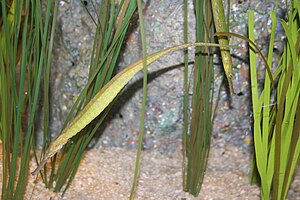Syngnathoides biaculeatus
| Syngnathoides biaculeatus | ||||||||||||
|---|---|---|---|---|---|---|---|---|---|---|---|---|

Syngnathoides biaculeatus |
||||||||||||
| Systematics | ||||||||||||
|
||||||||||||
| Scientific name of the subfamily | ||||||||||||
| Syngnathoidinae | ||||||||||||
| Duncker , 1915 | ||||||||||||
| Scientific name of the genus | ||||||||||||
| Syngnathoides | ||||||||||||
| Bleeker , 1851 | ||||||||||||
| Scientific name of the species | ||||||||||||
| Syngnathoides biaculeatus | ||||||||||||
| ( Bloch , 1785) |
Syngnathoides biaculeatus is a species of fish from the family of pipefish (Syngnathidae) in the Red Sea and the tropical Indo-Pacific from the coast of East Africa and South Africa (west to Knysna ) to the southern Japan, New South Wales and Samoa occurs.
features
Syngnathoides biaculeatus becomes 28 to 29 cm long and has a very elongated, thin body. Depending on the habitat, it is variable in color from green to brown or gray. During courtship, the females show a striking color on the belly side. The snout with the upper mouth is elongated like a pipette.
- Fin formula : dorsal 38–48, anal 4.
Way of life
Syngnathoides biaculeatus lives mainly in protected lagoons between algae, sea grasses or driving Tangen . In case of danger, the fish can jump over the water surface onto the dry top of the plants and stay there for some time. It feeds on zooplankton, small crustaceans and fish larvae. As with all pipefish, the eggs are taken over by the male when mating and then carried open on the underside of the tail until the young hatch.
Systematics
Syngnathoides biaculeatus is assigned to the polyphyletic subfamily "Syngnathinae" in most systematics . Although the breeding zone in the males before the anus , below the hull, Syngnathoides biaculeatus so far so the Gastrophori would be assigned, the species is listed as a sister group of a clade of Hypselognathus , Kaupus and Vanacampus deep within the Urophori where the breeding zone usually behind the anus lies on the underside of the tail.
Relationship with people
Syngnathoides biaculeatus is used in traditional Chinese medicine and is (rarely) kept as an aquarium fish. It has already been possible to breed the species in captivity.
literature
- Rudie H. Kuiter : Seahorses: pipefish, shredded fish and their relatives . Ulmer (Eugen), 2001, ISBN 3-80013-244-3
- ^ N. Wilson, & G. Rouse (2010). Convergent camouflage and the non-monophyly of 'seadragons' (Syngnathidae: Teleostei): suggestions for a revised taxonomy of syngnathids. Zoologica Scripta doi : 10.1111 / j.1463-6409.2010.00449.x
Web links
- Syngnathoides biaculeatus on Fishbase.org (English)
- Syngnathoides biaculeatus inthe IUCN Red List of Threatened Species 2013.1. Posted by: Bartnik, S., Morgan, Pogonoski, J., Pollard, D. & Paxton, J., 2008. Retrieved September 20, 2013.